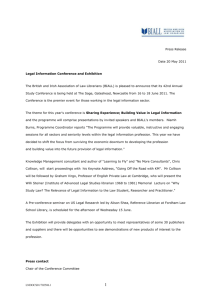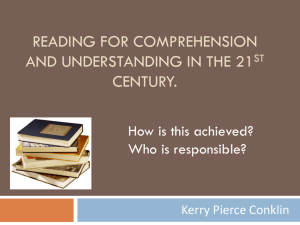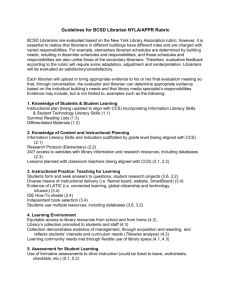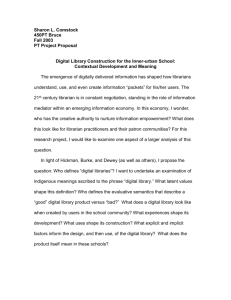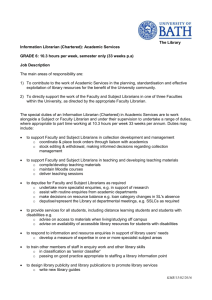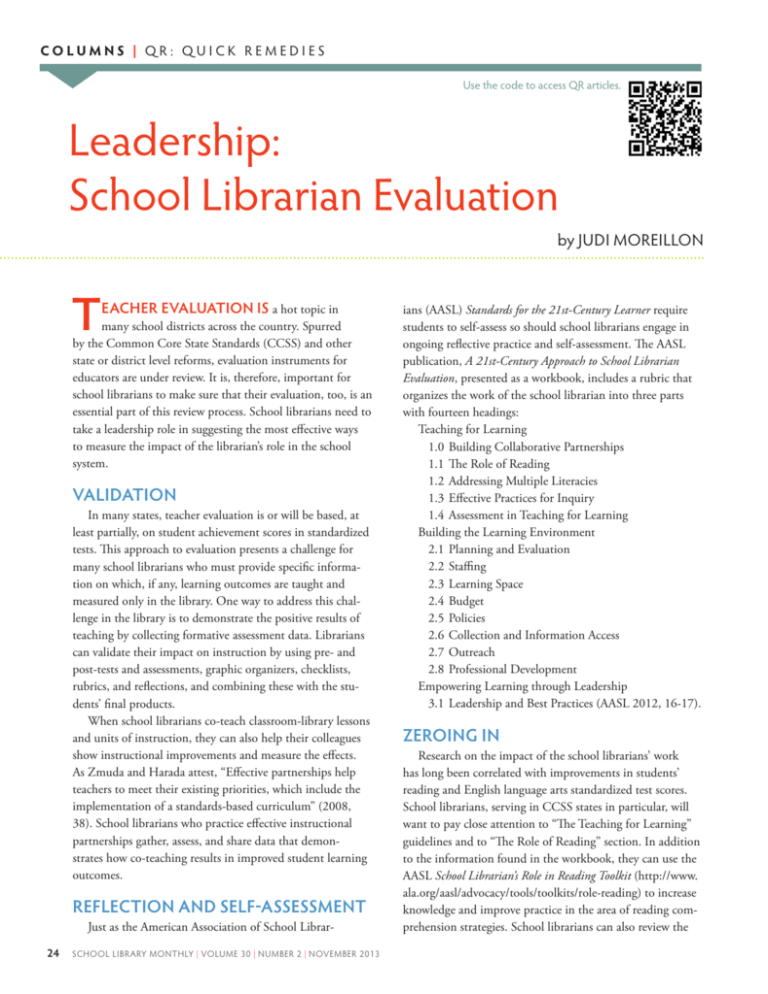
COLUMNS | QR: Q UICK RE M EDI ES
Use the code to access QR articles.
Leadership:
School Librarian Evaluation
by JUDI MOREILLON
T
EACHER EVALUATION IS a hot topic in
many school districts across the country. Spurred
by the Common Core State Standards (CCSS) and other
state or district level reforms, evaluation instruments for
educators are under review. It is, therefore, important for
school librarians to make sure that their evaluation, too, is an
essential part of this review process. School librarians need to
take a leadership role in suggesting the most effective ways
to measure the impact of the librarian’s role in the school
system.
VALIDATION
In many states, teacher evaluation is or will be based, at
least partially, on student achievement scores in standardized
tests. This approach to evaluation presents a challenge for
many school librarians who must provide specific information on which, if any, learning outcomes are taught and
measured only in the library. One way to address this challenge in the library is to demonstrate the positive results of
teaching by collecting formative assessment data. Librarians
can validate their impact on instruction by using pre- and
post-tests and assessments, graphic organizers, checklists,
rubrics, and reflections, and combining these with the students’ final products.
When school librarians co-teach classroom-library lessons
and units of instruction, they can also help their colleagues
show instructional improvements and measure the effects.
As Zmuda and Harada attest, “Effective partnerships help
teachers to meet their existing priorities, which include the
implementation of a standards-based curriculum” (2008,
38). School librarians who practice effective instructional
partnerships gather, assess, and share data that demonstrates how co-teaching results in improved student learning
outcomes.
REFLECTION AND SELF-ASSESSMENT
Just as the American Association of School Librar24
SCHOOL LIBR ARY MONTHLY | VOLUME 30 | NUMBER 2 | NOVEMBER 2013
ians (AASL) Standards for the 21st-Century Learner require
students to self-assess so should school librarians engage in
ongoing reflective practice and self-assessment. The AASL
publication, A 21st-Century Approach to School Librarian
Evaluation, presented as a workbook, includes a rubric that
organizes the work of the school librarian into three parts
with fourteen headings:
Teaching for Learning
1.0Building Collaborative Partnerships
1.1The Role of Reading
1.2Addressing Multiple Literacies
1.3Effective Practices for Inquiry
1.4Assessment in Teaching for Learning
Building the Learning Environment
2.1Planning and Evaluation
2.2Staffing
2.3Learning Space
2.4Budget
2.5Policies
2.6Collection and Information Access
2.7Outreach
2.8Professional Development
Empowering Learning through Leadership
3.1Leadership and Best Practices (AASL 2012, 16-17).
ZEROING IN
Research on the impact of the school librarians’ work
has long been correlated with improvements in students’
reading and English language arts standardized test scores.
School librarians, serving in CCSS states in particular, will
want to pay close attention to “The Teaching for Learning”
guidelines and to “The Role of Reading” section. In addition
to the information found in the workbook, they can use the
AASL School Librarian’s Role in Reading Toolkit (http://www.
ala.org/aasl/advocacy/tools/toolkits/role-reading) to increase
knowledge and improve practice in the area of reading comprehension strategies. School librarians can also review the
CCSS “6 shifts” especially in relationship to close reading,
text complexity, and citing evidence (Pattison 2013). These
are specific areas in which school librarians can demonstrate
that classroom-library instruction is making a difference.
The “Effective Practices for Inquiry” section will also help
align school librarians’ work to current initiatives in teaching
and learning. The CCSS use the term “research” when,
in fact, these standards describe what the school librarian
profession refers to as “inquiry.” Inquiry is a student-centered
approach to information problem solving in which learners
immerse themselves in information and engage in reflection
throughout the process. They develop and revise their
own questions and gather resources and
information independently to seek answers
and solve information problems. Finally,
students synthesize their understandings,
self-assess and share their new knowledge,
and once again engage in reflection
at the end of the process. Integrating
reading comprehension strategies using
think-alouds into inquiry lessons is a
required activity for school librarians whose goal is to make
measurable improvements in students’ reading proficiency
while ensuring they are effective users and producers of ideas
and information.
MEASURABLE DIFFERENCE
Being an essential part of the school’s academic program
is one way to be part of the solution to the literacy challenges
that students and teachers face. While school librarians
must demonstrate their value through exemplary practice
in all five roles, their contributions to student learning must
be most visible to library stakeholders. The educational
environment is ripe for school librarians who strive to make
a measurable difference in student learning outcomes. In this
time of change, it behooves school librarians to set the bar
high for their own contributions to the academic programs
in their schools.
The educational environment is ripe for school
librarians who strive to make a measurable
difference in student learning outcomes.
TELLING THE STORY
A quick self-assessment tool for school librarians,
“School Librarian Self-Assessment: Five Roles of the School
Librarian,” (Moreillon and McKee 2010) outlines the five
roles described in Empowering Learners: Guidelines for School
Library Programs (AASL 2009). See “Use This Page” on page
59 of this issue of School Library Monthly. While it is up
to the individual school librarian to determine criteria that
indicate each level of proficiency on the Likert scale, with
zero being the least developed to five representing exemplary
practice, the tool provides a relative measure for strengths
and weakness in each of the roles. This self-assessment can
also be used by school librarians to guide their state and
national conference session participation and professional
development plans.
“School Librarian Self-Assessment: Five Roles of the
School Librarian” (Moreillon and McKee 2010) has been
used in presentations to preservice school principals enrolled
in a supervision and curriculum course. This self-assessment
tool provides a shorthand view of the various skills and
responsibilities of a 21st-century school librarian and gives
school administrators a one-page snapshot of what to expect
in a library program. Preservice administrators who have
reviewed this document are impressed with the range of the
school librarian’s expertise and the potential global impact of
the library program on learning and teaching.
REFERENCES:
American Association of School Librarians (AASL). A 21st-Century Approach to School Librarian Evaluation. American Association of School
Librarians, 2012.
American Association of School Librarians (AASL). Empowering Learners:
Guidelines for School Library Programs. American Association of School
Librarians, 2009.
Common Core State Standards Initiative (CCSS). 2010. http://www.corestandards.org/the-standards (accessed July 14, 2013).
Moreillon, Judi and Becky McKee. School Librarian Self-Assessment: Five
Roles of the School Librarian. Assessment tool used in course presentations, School of Library and Information Studies, Texas Woman’s
University, Denton, TX, 2010.
Pattison, Darcy. Making the Common Core Practical: 6 Shifts in Learning:
CCSS Style. http://commoncorestandards.com/ela/6-shifts-in-learningccss-style (accessed July 18, 2013).
Zmuda, Allison, and Violet H. Harada. Librarians as Learning Specialists:
Meeting the Imperative for the 21st Century. Libraries Unlimited, 2008.
ADDITIONAL RESOURCES:
American Association of School Librarians (AASL). School Librarian’s Role
in Reading Toolkit. http://www.ala.org/aasl/advocacy/tools/toolkits/rolereading (accessed July 14, 2013).
American Association of School Librarians. Standards for the 21st Century
Learner. American Library Association, 2007. (Downloadable for free at:
http://www.ala.org/aasl/standards).◀
See “Use This Page” on page 59 of this issue of
School Library Monthly for the School Librarian
Role Assessment Tool.
Judi Moreillon, Ph.D., is assistant professor in the School of Library and Information Studies, Texas Woman’s University,
Denton, TX. She has served as a school librarian at every instructional level. Email:
info@storytrail.com
SCHOOL LIBR ARY MONTHLY | VOLUME 30 | NUMBER 2 | NOVEMBER 2013 25
U S E T H I S PA G E
School Librarian Role Assessment Tool
The following tool was created by Judi Moreillon and Becky McKee at School of Library and Information Studies, Texas Woman’s University, Denton, Texas. It can be used by school librarians to assess how well they are fulfilling the five roles outlined in
the guidelines developed by the American Association of School Librarians (AASL) for school librarians and programs (AASL
2009). See Moreillon’s article on pages 24-25 of this issue of SLM.
SCHOOL LIBRARIAN SELF-ASSESSMENT: FIVE ROLES OF THE SCHOOL LIBRARIAN
▶Leader ▶Instructional Partner ▶Information Specialist ▶Teacher ▶Program Administrator
Based on the roles and descriptors found in Empowering Learners: Guidelines for School Library Programs (AASL, 2009, pp. 16-18).
ROLEASSESSMENT
Leader:
•Serves as teacher leader
1
2
3
4
5
•Takes a global view of the school
1
2
3
4
5
•Integrates 21st-century skills throughout the school environment
1
2
3
4
5
•Demonstrates commitment and knowledge
1
2
3
4
5
•Builds relationships and partnerships
1
2
3
4
5
1
2
3
4
5
•academic standards,
1
2
3
4
5
•critical thinking, 1
2
3
4
5
•technology and information literacy, 1
2
3
4
5
•social skills, 1
2
3
4
5
•and cultural competencies.
1
2
3
4
5
•Integrates technology tools
1
2
3
4
5
•Creates engaged learning tasks
1
2
3
4
5
•Connects school with global community
1
2
3
4
5
•Models emerging technologies
1
2
3
4
5
•Models ethical use of information
1
2
3
4
5
•critical thinkers, 1
2
3
4
5
•enthusiastic and strategic readers, 1
2
3
4
5
•skillful researchers,
1
2
3
4
5
Instructional Partner:
•Develops policies, practices, curricula
•Collaborates with colleagues to codesign instruction, coteach, and coassess:
Information Specialist:
Teacher:
•Empowers students to become
•and ethical users of information.
1
2
3
4
5
•Follows trends in reading materials
1
2
3
4
5
•Advocates for resources in all formats
1
2
3
4
5
•Provides equal access to resources
1
2
3
4
5
•Co-develops library’s mission, strategic plan, and policies
1
2
3
4
5
•Manages staff, budget, and physical space
1
2
3
4
5
•Partners with stakeholders and other organizations
1
2
3
4
5
Program Administrator:
American Association of School Librarians. Empowering Learners: Guidelines for School Library Programs. Chicago: American Association of School Librarians, 2009.
All rights reserved. Permission granted by School Library Monthly (Vol. XXX, No. 2) to reproduce for nonprofit educational purposes. http://www.schoollibrarymonthly.com.
SCHOOL LIBR ARY MONTHLY | VOLUME 30 | NUMBER 2 | NOVEMBER 2013 59


